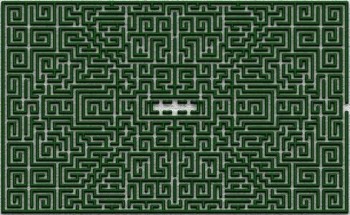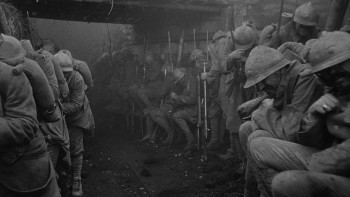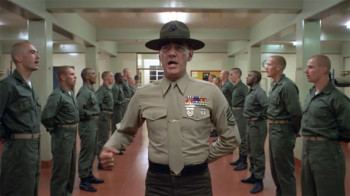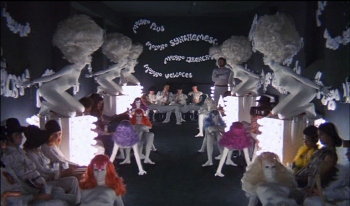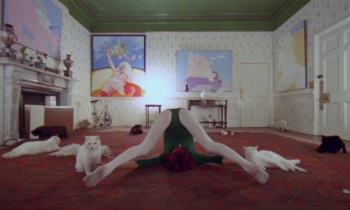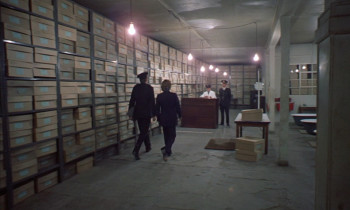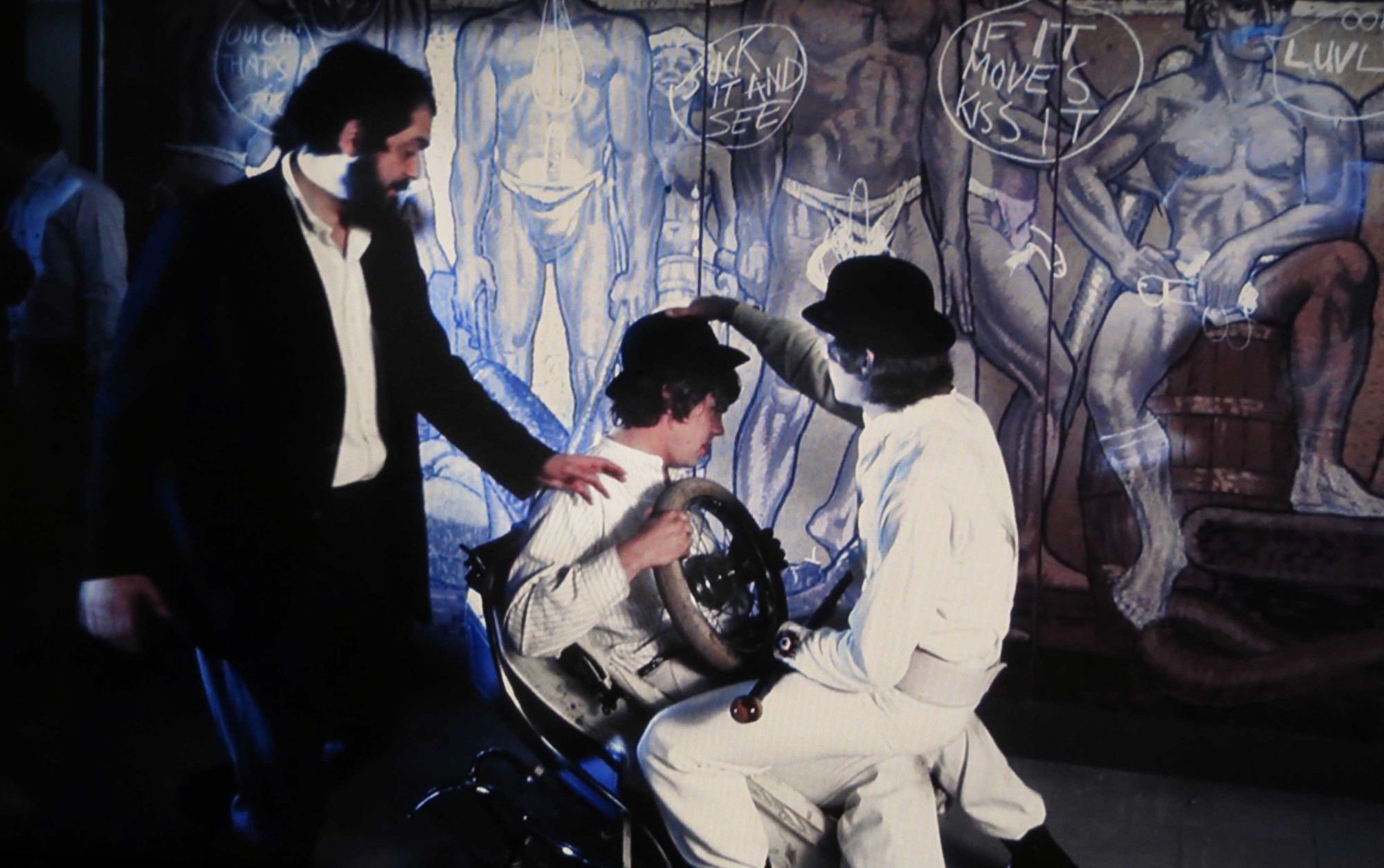
Stanley Kubrick by ShortFilmWindow
June 10th, 2016
It is generally said about Kubrick that all his films deal with such diverse subjects that it is hard to believe that it is made by the same person. In this essay I would try to formulate my synthesis of his films with emphasis on his philosophy, architecture, sound, music and use of colors.
The initial part deals with the philosophy and the latter part takes about his crafts and technicalities that enabled him to realize the above philosophies and create masterpieces.
The Philosophy behind Stanley Kubrick’s work:
1) The emotions and the unconscious: He once said that a Beatles song is enjoyed alike by a Harvard Graduate and a truck driver even when they hugely differ in their intellect. One the reasons his movies (some made around 50 years ago for American audience) still continue to strike a chord with 20 year old audience today is his understanding of the faculties of human emotions and the unconscious. Kubrick constructed his mise-en-scenes such that they produced immediate emotional response but at the same time had unconscious bearing that would be revealed on further contemplation. The scenes had very thoughtful and crafty layering and hence most of his movies stood apart. His movies were quite like the process of individuation proposed by Carl Jung where a bridge was made between the realities of conscious mind and the desires of unconscious mind. He chose stories were the characters were confronted with their unconscious desires coming true. At the same time he ensured that a conscious autonomy of the scenes were maintained (I found the end of 2001 A Space Odyssey the only place where was lost for some of the audience who refused to slip into the unconscious world that Kubrick constructed). Amongst popular Indian filmmakers and film industries there is always a divided opinion about the purpose of cinema. Some says it is a medium that provides escapism where one can forget the daily life and enjoy while others say that cinema should mirror the society to awaken them. Kubrick does both because he has a way of absorbing you into a fictitious world and still provide insights that are universal and relevant to the society. He has sometimes used unrealistic – past or future or fictitious settings to convey universal emotions that are very relevant to day to day life. It is remarkable how he has used surrealism (unseen places in physicality) to convey something extremely real.
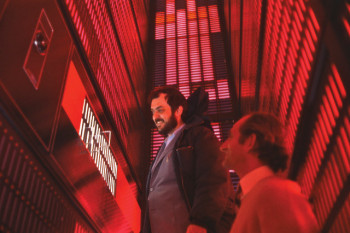 2) Man is imperfect: And hence all his constructions and inventions are. And this doesn’t limit to computers and machines like HAL (2001 Space Odyssey) but also extend to the constructions of societies and the formation of nations. If it was not so, we would not be suffering from threats of nuclear war and global warming. Wrestling matches, prostitution etc are legalized outlets of the feelings that cannot be totally eliminated in the process of domestication. What exists in the man, exists in the society too. There are invented virtues like non-violence, loyalty, patriotism that makes our societies function so that a man-made institution or concept (for example marriage, nation, society) and is higher than any individual man. I have found Kubrick in many of his movies questioning that. Kubrick tries to bring these marginalized issues in the forefront and brings it at the loggerheads with a completely domesticated society. For me the most outrageous parts Lolita is Humbert who is a civilized English professor (and enjoys the subtleties of any poem and) is in love with the daughter of the woman he has married, contemplates killing the mother. These feelings exist but are never verbalized. Lots of times Kubrick brings to forefront the desires that exist but not allowed to be voiced in the society. There is a power structure that exists in the society and majority of the films confirm to it. It provides validation to our belief system. We see movies even when we know there is a happy ending because we find reassurance in the moral values imparted to us where good happens to good people and bad happens to bad people. Similarly there are exalted concepts like police, soldier, religion, nation and our faith on them has to be constantly reinstated. Kubrick tries to challenge this faith and these concepts.
2) Man is imperfect: And hence all his constructions and inventions are. And this doesn’t limit to computers and machines like HAL (2001 Space Odyssey) but also extend to the constructions of societies and the formation of nations. If it was not so, we would not be suffering from threats of nuclear war and global warming. Wrestling matches, prostitution etc are legalized outlets of the feelings that cannot be totally eliminated in the process of domestication. What exists in the man, exists in the society too. There are invented virtues like non-violence, loyalty, patriotism that makes our societies function so that a man-made institution or concept (for example marriage, nation, society) and is higher than any individual man. I have found Kubrick in many of his movies questioning that. Kubrick tries to bring these marginalized issues in the forefront and brings it at the loggerheads with a completely domesticated society. For me the most outrageous parts Lolita is Humbert who is a civilized English professor (and enjoys the subtleties of any poem and) is in love with the daughter of the woman he has married, contemplates killing the mother. These feelings exist but are never verbalized. Lots of times Kubrick brings to forefront the desires that exist but not allowed to be voiced in the society. There is a power structure that exists in the society and majority of the films confirm to it. It provides validation to our belief system. We see movies even when we know there is a happy ending because we find reassurance in the moral values imparted to us where good happens to good people and bad happens to bad people. Similarly there are exalted concepts like police, soldier, religion, nation and our faith on them has to be constantly reinstated. Kubrick tries to challenge this faith and these concepts.
3) Dichotomy/dual nature of man: So what is a better choice: die trying to fight slavery or live as a slave(Spartacus), stay apparently faithful and mentally stray or stray, (Eyes Wide Shit), fight and kill or advocate for peace (Full Metal Jacket). Man is guided both by instinct and intellect. I feel that instinct deals with an event in isolation while the intellect deals with the context of the milieu one is in. Kubrick places his characters in a situation where they are trying to walk the thin line between the two, sometimes stepping here, sometimes stepping there. He focuses their innate human frailties.
The CRAFT of Stanley Kubrick Architecture, Sound, Music, Colors:
Kubrick’s films were known for their bold, flawless, impeccable scenes. Below are certain things that stood out.
Architecture: Kubrick used architecture in such a way that elements like window, columns, corridors and staircases acquired symbolic and narrative functions in his movie
Following is the table that talks about some of his architectural pre-occupations. Color would be dealt separately.
| Emotions | Movies | Architecture | Function |
| Battle place, military | Full Metal Jacket, Paths of Glory, War scenes of Barry Lyndon, maze in The Shining | Straight lines - columns, uniform, simple functional architecture almost like drawn with scale, no decoration. | Military has been associated with precision. Any space is actually container of action and there is no room for frills. |
| Large groups of men as architectural element | Full Metal Jacket, Spartacus, Paths of Glory, The killer | Long shots of large amount of men arranged in various shapes (like in Triumph of the Will documentary of Hitler) | In Spartacus, he has used large collection of humans (soldiers) as an architectural element. Similarly in Paths of Glory, in the execution scene he has used large amount of men.Similarly in Full Metal Jacket, all men are arranged like columns when inside the room and as group when on the field.In the climax scenes of The Killer (low budget film), in the fighting scene with axe, Kubrick used lots of mannequins and their body parts to add to the drama. |
| Levels, progression, Grandeur | Lolita, The Shining, Barry Lyndon, Eyes Wide Shut | The large staircases and the direction in which the protagonists climb them has been used very effectively by Kubrick. | In Lolita – the first time she is shown climbing is the first time we see Humbert’s and her interaction, In The Shining the first time they climb is when Jack’s wife understands Jack going crazy. Staircase is also used to effectively show the grandeur of the architecture (like Raj Kapoor in India). |
| Going from one space to another | All movies | Long corridors | Corridors have no function. One cannot live in there or sit in there. The function is of connecting different spaces . Kubrick uses thin corridors effectively, almost like a tunnel which puts audience in a position of discovering what should be at the end of the tunnel. The instinct to discover it, claimed by lots of psychologist is similar to the instinct of getting born - through a tunnel. |
| Material used for the architecture | The Shining, Clockwork Orange, Barry Lyndon, 2001 A space Odyssey | Each material lends itself to a different feel. Kubrick tries to exploit it by using sound design. | The Shining: Wooden floor (and carpets) and walls (with a reverb when the ball is hit). The maze is made up of green plants and not concrete.The clockwork orange: The writer has clear wooden floor, the cat lady has carpet, Alex’s own home has a toy/plastic feel to it.2001 A Space Odyssey: It has spic and span white floors of undecipherable material, in the end, the floors have light emanating from them.Barry Lyndon: When the kid brother wears the elder brother’s shoes, he clomps on the wooden floor for it to sound more irritating and obstrusive. |
2001 A Space Odyssey :
Any fantasy movie should have that illusion of reality maintained and any break or error will totally spoil the effect of the movie. It will break the illusion. Kubrick achieves this in constructing immaculate production design. He also tries to bend our mind by showing architectures one wouldn’t envision with conscious mind but can have unconscious effect on us. Some key aspects of these are:
1) Circular corridors that defy gravity – To see the airhostess or the pilot go all around in any direction is a feature of a gravity-free environment. But it could be a square one too. He uses circular structure that lends itself to lots of subconscious and mythological impact. Circle also means endlessness, rounded/elliptical structures are more natural in terms of caves and more organic. Perfect squares are too manmade a structure. Eastern philosophies have the circular concept of time where we eternally go round in time. Also circular corridors lend themselves to smooth passage, where you cannot distinguish one spot from another.
2) Shape of the spaceship similar to body’s vertebrae: Never before and never later has someone shown 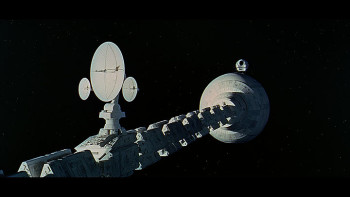
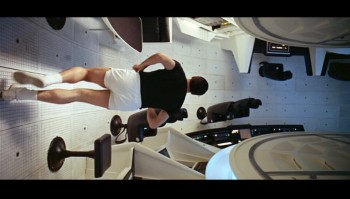 design of a spaceship with an immediately recognizable structure. Currently science is trying to take inspiration from human and animal bodies (Eagles for fighter planes, neural networks for artificial intelligence),
design of a spaceship with an immediately recognizable structure. Currently science is trying to take inspiration from human and animal bodies (Eagles for fighter planes, neural networks for artificial intelligence),
HAL designed as one-eyed monster present in Homer’s odyssey.
The Shining:
1) Maze : The maze is a structure also not frequently seen. It is an inhabitable piece of architecture. Once the person is in it, he wants to get out. 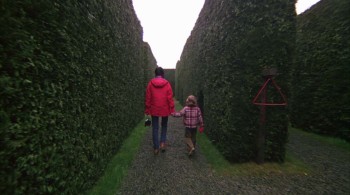 There is this fear of being lost forever – not knowing whether every turn is leading one closer or farther away from the exit. This architecture attacks our primal instincts of security, of having the need to fathom our surroundings, of breaking away from any sense of claustrophobia. Kubrick, tries to compare this maze with the hotel (using various dissolves when the maze is first shown) and tries to bring parallelism between the hotel as a maze (mental) and the outside garden maze as a physical maze. In the climax shots Jack tries to follow his son in this maze while his wife is hallucinating in the hotel’s man-made maze.
There is this fear of being lost forever – not knowing whether every turn is leading one closer or farther away from the exit. This architecture attacks our primal instincts of security, of having the need to fathom our surroundings, of breaking away from any sense of claustrophobia. Kubrick, tries to compare this maze with the hotel (using various dissolves when the maze is first shown) and tries to bring parallelism between the hotel as a maze (mental) and the outside garden maze as a physical maze. In the climax shots Jack tries to follow his son in this maze while his wife is hallucinating in the hotel’s man-made maze.
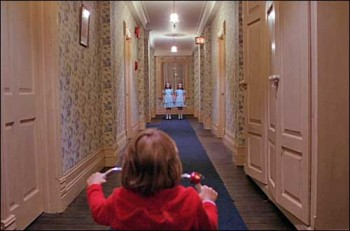 2) The hotel: The hotel itself with its long corridors and great sound design employed in mundane acts (ball hitting), cycle over the wooden floor is akin to a maze but is most importantly presented as an unfathomable structure. We are also given a tour (when the manager takes Jack around), but still we do not understand the map of entire hotel. Also he chose 4:3 aspect ratio for his movie that made those columns of the hotel room more prominent.
2) The hotel: The hotel itself with its long corridors and great sound design employed in mundane acts (ball hitting), cycle over the wooden floor is akin to a maze but is most importantly presented as an unfathomable structure. We are also given a tour (when the manager takes Jack around), but still we do not understand the map of entire hotel. Also he chose 4:3 aspect ratio for his movie that made those columns of the hotel room more prominent.
3) Element of snow as architecture: When it snows, one wants to be indoors and safe. But what if there is a killer inside and vast expanse of snow outside. Kubrick effectively plays with that tension.
Lolita:
1) Dream world: The opening shot is shown more as a mental space. There are times when we dream, a person we went to school with is with the person we met randomly on the train. The space time limitations are broken. When Humbert comes to kill Quilty the scene has these elements – packing and unpacking, table tennis in the living room, same paintings in more than one locations.
Clockwork Orange:
1) The decaying society: The milkbar itself has traces of underwater decadence. The locality of Alex and the paintings on his wall also imparts that feeling.
2) Prison as uniform with shelfs stacked with boxes and series of bathtub and with a line drawn for prisoners
3) Cats as architectural element
Paintings in cat lady’s house to inform about the upper class orientation towards art
4) Hospital where he gets his Ludvico treatment is more like a cold military setting.
5) The setting of the actual treatment is quite similar to Plato’s cave (http://www.thatmarcusfamily.org/philosophy/Course_Websites/Phil_Math/Photos/Cave.jpg).
SOUND DESIGN to manipulate emotions:
Kubrick is one of the pioneers in sound design from which lots of post modern cinema like of Tarentino’s takes inspiration from. He not only made intelligent use of digetic sound to convey various meanings but also very interesting used non-digetic sound and pioneered the use of music.
1) Use of digetic sound: Kubrick picked and chose the relevant digetic sounds to highlight the narrative. I mentioned above in case of showing the expanse and material of the architecture how he cleverly used the sound design in The Shining. In other places he used it to create mood – like the suicide of Bomer Pyle in Full Metal Jacket where one hear a periodic metallic sound, the sound of shields cutting the air in Spartacus. Infact the tune of the songs sung by the prisoners in Full Metal Jacket resonated in my ears for the following two days, such was the impact of the song without music and sung in the same tune.
In Spartacus, in the battle scene, the cuts are around the sound of trumpet and the drums. Something like this is later seen in Lord of the Rings. In 2001 A space Odyssey, he used the sound of the astronaut breathing inside the helmet to highlight the point of him being suffocated to death later when the tube of oxygen supply tune is broken. Note that the sound effect contains no sound except him breathing. Similarly in Full Metal Jacket when the men are charging towards the sniper, the sound is only of their footsteps, all the ambience sound was brought down to zero. Another example is in Clockwork Orange where we hear the sound of the cat lady hitting Alex but not Alex hitting the cat lady to make the violin feel more palatable .
2) Use of non-digetic sound effects: In Paths of Glory, one noticed the sound of Lion’s roar when the hero walks in through the trench, and the sound of military march when the General walks in, the scary piano keys in Eyes Wide Shut when Tom Cruise is caught during the orgy scene and is in the verge of being caught later. The sound design of the shining leading to a high point and then cutting to a slide showing Tuesday, not giving a moment of relief.
3) Pioneering use of music: In later movies, Kubrick increasingly became mood centric rather than plot centric. He felt that a movie should be succession of mood and minimized the use of dialogues for it to have more universal appeal. He started believing that movie is more a medium of visual story-telling and less dialogue based.
For example, in ClockWork Orange where he manipulates us to see violence from Alex point of you. Since it is an enjoyable experience for him, it should be an enjoyable experience for us too. So the violence happens in slow-motion with music going on in the background. Ofcourse lots of people have now taken inspiration from it but this was the first time something like this was done. Using almost contrasting soothing music to show violence. The second is in 2001 A Space Odyssey where the space ships were shown. Lots of Hollywood flicks shows it zooming right across but no one celebrates it with music, the way Kubrick does. The spaceship experience with that music feels like a mundane experience.
4) Language and accent as product of the environment and narrative device:
In every Kubrick’s movie, the language/accent with which the characters spoke was product of the environment they were in. It lent itself to the authenticity of the characters. Following are the examples:
Full metal jacket – the abusive, firm language of the instructor
Clockwork orange – the invented language of Alex and his gang
2001, A Space Odyssey - The precise Brit accent of HAL computer
Lolita – Humbert was from European (Paris) and from his accent itself he was different from the Americans. It gave him a distinct characteristic and set him apart from everyone else.
Accuracy of details:
Accuracy of small details helped in building up the reliability. As mentioned earlier Kubrick nursed ideas for long periods. Right from the various elements put in the military packet in Dr. Strangelove, food in 2001 A Space Odessey, pieces of brains being blown out in Full Metal Jacket . His attention and thoughts given to every detail was exemplary. Because of this, his story telling was more realistic, and less stereotype. The attention was not just limited to the production design element but also gestures. These new images that we saw were the ones that stayed with us long after the movie was seen. These details added the repeatability of the movie. His characters were nuanced, none completely black and completely white. A little unpredictable. Even at the script level, there were layers talking about various things, like violence as integral part of infantile nature of man in Clockwork Orange, the history of violence (esp against Red Indians) in The Shining, having a tender love for the person whom you are betraying in Eyes Wide Shut. These details did not exhaust the movie in the first viewing. Every viewing infact provided something new. Also we knew that apart from the entertainment the movie provided, there were treasures tucked in the movie which kept bringing us back to the movie. This gave his movie his unique fingerprint and repeatability and an aftertaste that lingered on.
Use of COLORS:
Every color has a psychological impact on us. It is difficult to state but is certainly felt. The colors like bright red unsettles us and the colors like blue gives us some calmness. Kubrick plays a lot with those colors and their use is clearly seen in all his movies. I particularly like The Shining where he used warm red tones and well-lighted corridors. A departure from lots of horror movies where the ghosts are found in the dark. In lot of places he used warm and cold lights together in the same frame – e.g. bathroom scene of eyes wide shut.
Kubrick used a narrator in most of his movies, in Clockwork Orange, it was Alex himself and in some like Barry Lyndon it was a third narrator. There are various other features of Kubrick’s work like use of bold shots – he never did anything small, great casting (The Shining is a good example), and maintaining a narrative tension – in none of his movies at no point one felt that there is nothing to be discovered. Some might debate that Kubrick’s movies though flawless left them cold, really didn’t move them emotionally. Kubrick really never gave a happy ending, except for Paths of Glory where the soldiers hummed to the tune. Lot many times he left audience with an unsettled feeling. Nonetheless, his work continues to inspire films right from LOTR to Matrix (chase scenes) to 100 others and there is always something to takeaway when one watches his films.






